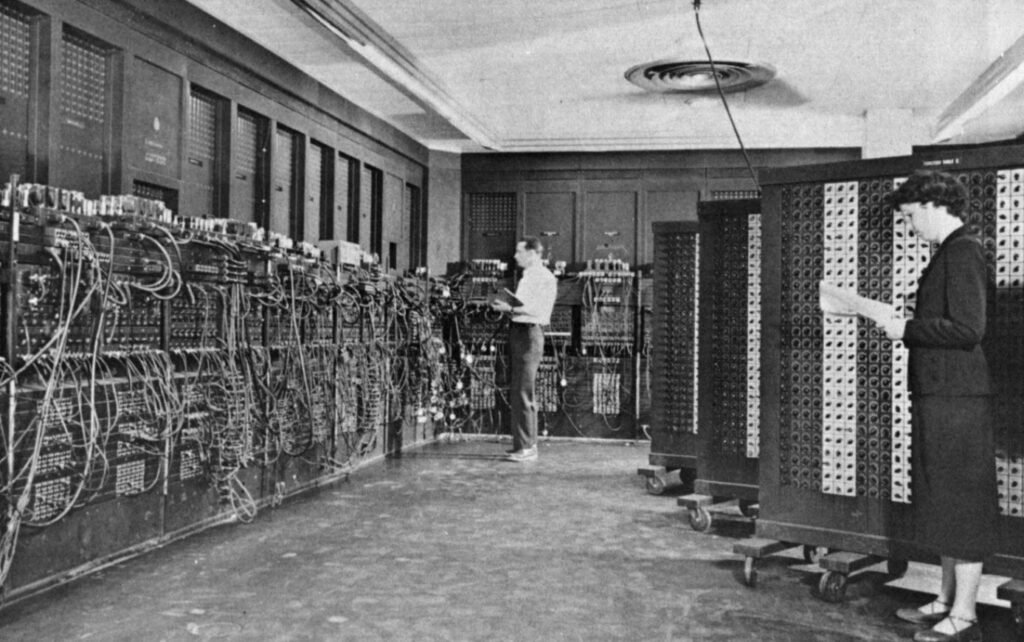
The history of computers is a remarkable journey that spans over centuries, from the visionary concepts of the 19th century to the astonishing feats of artificial intelligence in the present day. Each era in the evolution of computers has brought about revolutionary changes, shaping the way we live, work, and communicate.
Let’s embark on a journey through the five major generations of computers that have paved the way for the digital world we know today.
1. First Generation (1937–1946): The Birth of Computing
The seeds of modern computing were sown in the 19th century when the English mathematician Charles Babbage conceptualized the “Analytical Engine.” However, it was during the first generation, from 1937 to 1946, that the first tangible steps were taken. Engineers J.P. Eckert and J.W. Mauchly unveiled the Electronic Numerical Integrator and Computer (ENIAC) between 1943 and 1945.
This behemoth, powered by vacuum tubes, consisted of over 20,000 tubes, 70,000 resistors, and 10,000 capacitors. Weighing a staggering 30 tons, ENIAC was a symbol of both innovation and enormity.
2. Second Generation (1947–1962): The Transistor Revolution
The advent of the transistor marked the dawn of the second generation of computers, spanning from 1947 to 1962. This era saw the birth of Universal Automatic Computer (UNIVAC 1), the first commercial computer built using transistor technology.
IBM followed suit with its 650 and 700 series computers in 1953. This period witnessed the emergence of computer programming languages and assembly languages, reshaping how humans interacted with machines.
3. Third Generation (1963–1971): The Rise of Integrated Circuits
The third generation of computers, from 1963 to 1971, was characterized by the integration of circuits (ICs) into the computing landscape. Silicon-based technology allowed for the miniaturization of transistors, leading to the creation of smaller, more powerful computers.
Keyboards replaced punch cards, and multitasking operating systems emerged, enabling the simultaneous execution of multiple applications. Notable machines of this era include IBM 360 & 370 and DEC PDP-11.
4. Fourth Generation (1971–2010): The Personal Computing Revolution
The fourth generation, spanning from 1971 to 2010, brought computing to the masses with the advent of Very Large-Scale Integration (VLSI) microprocessors. This era witnessed the rise of personal computers (PCs), laptops, and other consumer-oriented devices.
A plethora of operating systems, including Windows, Linux, UNIX, Solaris, and Macintosh, were introduced, catering to various user preferences. The technology landscape diversified, ushering in an era of rapid innovation and digital empowerment.
5. Fifth Generation (2010–Present): The Age of Artificial Intelligence
The fifth generation of computers, beginning in 2010 and continuing into the present day, is characterized by the pervasive influence of artificial intelligence (AI) and ultra-large-scale integration (ULSI).
While AI had been in development for decades, its impact reached new heights in this era. AI-powered systems, such as IBM Watson, emerged alongside multicore and distributed processing machines. Mobile devices and tablets equipped with advanced AI capabilities became integral parts of our lives, redefining how we interact with technology.
In Conclusion
The history of computers is a testament to human ingenuity and innovation. From the visionary concepts of the 19th century to the AI-driven marvels of today, each generation of computers has brought us closer to the digital age we inhabit.
The evolution of computers has reshaped industries, transformed communication, and empowered individuals in ways unimaginable to those who first conceived the notion of a mechanical Analytical Engine. As we continue to push the boundaries of technological advancement, the legacy of each generation of computers serves as a reminder of our ability to shape and redefine the future.
You may also like:- How To Fix the Crowdstrike/BSOD Issue in Microsoft Windows
- MICROSOFT is Down Worldwide – Read Full Story
- Windows Showing Blue Screen Of Death Error? Here’s How You Can Fix It
- A Guide to SQL Operations: Selecting, Inserting, Updating, Deleting, Grouping, Ordering, Joining, and Using UNION
- Top 10 Most Common Software Vulnerabilities
- Essential Log Types for Effective SIEM Deployment
- How to Fix the VMware Workstation Error: “Unable to open kernel device ‘.\VMCIDev\VMX'”
- Top 3 Process Monitoring Tools for Malware Analysis
- CVE-2024-6387 – Critical OpenSSH Unauthenticated RCE Flaw ‘regreSSHion’ Exposes Millions of Linux Systems
- 22 Most Widely Used Testing Tools








